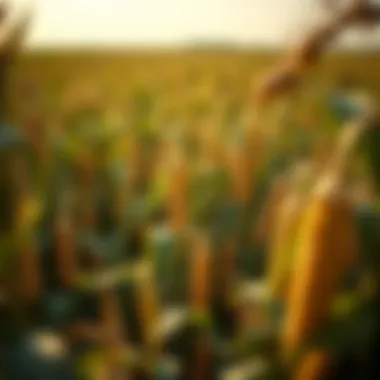Understanding the Growth Process of Soybeans


Intro
Soybeans have woven themselves into the very fabric of modern agriculture—not just as a staple food source but also as a player in various industrial applications. This leguminous crop, scientifically known as Glycine max, holds the key to protein-rich livestock feed, an array of food products, and even biofuels. Understanding the intricacies of soybean growth is vital for farmers, agronomists, and enthusiasts alike, especially as the demand for this versatile crop continues to rise globally.
Walking through the world of soybean cultivation involves more than just throwing seeds into the ground and hoping for the best. It’s a multi-layered dance between the environment, the soil, and agronomic practices that can either spell success or failure. The way one prepares the soil, the planting techniques they employ, and the constant monitoring throughout growth stages play critical roles in the eventual harvest.
This article takes you through the progression of soybean growth, spotlighting essential agronomic practices, environmental influences, and innovative farming techniques to achieve optimal yield. Together, we’ll navigate from the proud moment of seed germination to the anticipation of final yield—all while considering sustainable agricultural practices that meet the challenges of today’s farming.
Key Insights
Overview of the Topic
The journey from seed to harvest for soybeans is a complex pathway that encompasses several key stages: soil preparation, planting, growth, and harvesting. Each of these phases requires attention to detail and a focus on best practices. For instance, soil testing is crucial before planting to decipher nutrient needs, which can significantly influence plant health and crop quality. Understanding cropping systems, such as rotating soybeans with other crops, can enhance soil structure and fertility.
Importance in Agriculture/Horticulture/Agronomy
Soybeans represent a significant component of agricultural economics, serving as a major protein source worldwide. Furthermore, they play a role in enhancing soil nitrogen levels due to their ability to fix atmospheric nitrogen through symbiotic relationships with soil bacteria. Thus, cultivating soybeans doesn't only benefit farmers financially but also contributes positively to the soil ecosystem.
Sustainable Practices
Eco-Friendly Techniques
As environmental concerns grow, sustainable practices in soybean farming become more pressing. Methods such as cover cropping, reduced tillage, and integrated pest management are increasingly popular. Cover crops improve soil health, while reduced tillage minimizes soil erosion and improves carbon retention.
Here are some eco-friendly approaches to consider:
- Cover cropping: Enhances soil structure and fertility.
- Crop rotation: Helps break pest cycles and improve soil health.
- Water conservation: Techniques such as drip irrigation minimize water use.
- Organic farming: Focusing on natural inputs reduces chemical usage and promotes biodiversity.
Case Studies on Sustainability
One notable example is the implementation of no-till farming in Illinois, which has shown a marked improvement in soil structure and water retention. Farmers who adopted this practice have reported increased yields while also reducing their carbon footprint. For further insights, check the USDA's reports which provide case studies on various sustainable practices.
Tools & Resources
Essential Equipment and Technologies
Utilizing the right tools can streamline the soybean growth process. Key equipment includes:
- Planters: Ensures precise seed placement.
- Seed drills: Offers efficient planting and optimal spacing.
- Sprayers: For pest and nutrient applications.
- Harvesters: Modern combines can dramatically increase efficiency during harvest season.
Recommended Books and Readings
To further immerse yourself in soybean agronomy, these resources might be beneficial:
- "Soybeans: Improvement, Production, and Uses" by William R. Fehr.
- "Soil Fertility and Fertilizers" by John Havlin.
- Websites like Cornell University's agriculture page provide research and articles relevant to soybean farming practices.
For anyone serious about soybean cultivation, understanding the process in its entirety can be the difference between a mediocre harvest and a bountiful yield. By embracing both technological advancements and sustainable practices, farmers can enhance their productivity while protecting the environment.
Prelims to Soybean Cultivation
Soybean cultivation has taken center stage in the realm of modern agriculture, and it’s not just a trend; it’s a chase to meet the ever-growing demand for this versatile crop. Soybeans, scientifically known as Glycine max, hold immense significance from various angles. Understanding their cultivation isn’t just about planting seeds and waiting for them to grow. It encompasses a whole ecosystem of practices, from soil management to pest control, ensuring that every step contributes to not only yield but also sustainability.
The journey begins with acknowledging how critical soybeans are for food security and economic stability. Globally, these legumes are a staple, providing protein and oil for a multitude of products. Farmers who delve into soybean production tap into a profitable market with various applications ranging from livestock feed to industrial products. Furthermore, soybeans are key players in crop rotation systems that promote soil health, aiding in reducing pest cycles and improving nutrient cycling.
Engaging with soybean cultivation also involves examining environmental considerations. The crop’s ability to fix nitrogen in the soil means that growing soybeans can reduce the need for synthetic fertilizers, leading to a more eco-friendly farming approach. However, it doesn’t stop there; understanding the right cultivation techniques, varieties, and environmental impacts can lead farmers to greater profitability while maintaining the health of their land.
It's essential to consider various factors in this cultivation process including climate, soil type, and pest management strategies that come into play from sowing to harvest. Farmers armed with this knowledge will benefit not only in day-to-day operations but also in long-term sustainability practices.
In this article, we will explore detailed aspects of soybean growth, ensuring that those involved in agriculture gain a comprehensive understanding of this highly valuable crop. After all, the secret to successful soybean cultivation isn’t just knowing when to plant; it’s about mastering every element of the process that leads to a bountiful harvest.
Historical Significance of Soybeans
Soybeans, a crop often overlooked for its historical depth, carry rich narratives from ancient cultivation practices to modern agricultural revolutions. One might say that soybeans are not just beans; they are a storyline of humanity's agricultural evolution. Initially native to East Asia, the soybean's journey began thousands of years ago, with its domestication occurring in China around 1100 B.C.
The significance of this legume stretches beyond mere cultivation. It shaped economies and cultures. For example, the introduction of soybeans to Japan in the 8th century had profound influences on the diet and culinary practices of the region. Soybeans became essential not just as a food source but also as a means of sustaining agricultural ecosystems. Its proteins and oils provided nourishment, while the plant itself contributed to soil fertility—a classic case of nature helping to sustain itself.
In the United States, soybeans found their footing circa the early 20th century. What started as an experimental crop for crop rotation soon turned into a staple. By mid-century, American farmers embraced soybeans, recognizing their versatility and economic value. The rise in soybean cultivation was not merely by chance; it aligned with the exponential growth in demand following World War II. At the heart of this was the booming livestock industry that required protein-rich feed. The introduction of hybrid varieties further catalyzed production, leading to a tremendous increase in yield per acre.
"Soybeans are no longer just a crop; they have turned into a fundamental cornerstone for various industries and cuisines around the world."
🎯 Noteworthy impacts of soybeans include:
- Increased Food Security: Soybeans help meet the dietary needs of populations worldwide.
- Economic Growth: The soybean industry has become a multi-billion dollar sector, shaping agricultural policies and practices.
- Culinary Diversity: These legumes have given rise to numerous culinary innovations, from tofu to soy sauce, enriching global cuisine.
Moreover, in the global market, soybeans have carved a place as a major export commodity for countries like Brazil and Argentina, further underscoring their economic significance. This trade positions soybeans not just as a national asset, but as a crucial player on the international stage.
In recent decades, the advancing technology in genetic modification and breeding has generated new varieties that promise enhanced yields, disease resistance, and adaptability to climate change. This speaks to the ongoing relevance of soybeans in addressing modern agricultural challenges.
For an in-depth understanding of soybeans' role, refer to resources like Wikipeida and Britannica.
Understanding the Biology of Soybeans
The biology of soybeans is as intricate as it is essential to their cultivation. Understanding this biology allows farmers and enthusiasts alike to grasp the nuances involved in nurturing these plants from seed to harvest. The success of any agricultural venture often hinges on the fundamental biological processes at play, and soybeans are no exception. By learning about their genetic makeup and physiological traits, stakeholders can maximize yield while minimizing potential issues, ensuring a healthy crop balance.
A deeper understanding of soybean biology aids in selecting suitable growing conditions, identifies optimal management practices, and informs the choice of varieties tailored to specific regional climate challenges. In short, it creates a robust foundation from which effective farming strategies can be designed. Below, we delve deeper into two critical components of soybean biology: genetic makeup and physiological traits, shedding light on their significance in the cultivation process.
Genetic Makeup
The genetic makeup of soybeans significantly influences not only their growth but also their adaptability to various environmental conditions. Soybeans (Glycine max) are a part of the legume family, and their genome consists of multiple genes responsible for traits like yield, disease resistance, and drought tolerance. This genetic diversity forms the basis for successful breeding programs aimed at enhancing these traits.
Soybeans exhibit two major genetic groupings: determinate and indeterminate varieties. Determinate soybeans are characterized by their ability to set pods and limit vegetative growth, making them suited for regions with shorter growing seasons. On the other hand, indeterminate varieties continue to grow vegetatively while setting pods at the same time, providing flexibility in varied climates and allowing for adaptation to differing farm practices.
"Understanding the genetic foundation of soybean varieties is key for optimizing both yields and resilience under changing climate conditions."
Moreover, research into genetic modifications, such as gene editing technologies, has paved the way for the development of cultivars with enhanced disease resistance and adaptability. This novel approach not only addresses current challenges faced by soybean farmers but also facilitates preparation for future agricultural demands.
Physiological Traits
The physiological traits of soybeans encompass the plant's growth patterns, responses to environmental stimuli, and overall health. Key physiological factors include photosynthesis rates, nutrient uptake efficiency, and root depth. For example, soybeans are known for their ability to fix atmospheric nitrogen due to their symbiotic relationship with specific soil bacteria, which can reduce the need for additional nitrogen fertilizers and promote soil health.
A crucial aspect of soybean physiology revolves around water management, particularly in regions prone to drought or excessive moisture. Understanding how soybeans respond to varying water availability helps farmers modify irrigation practices to maintain healthy sap flow, which is essential for photosynthesis and nutrient transportation.
Moreover, the timing of physiological events, such as flowering and pod development, is dictated by the plant's internal biological clock, which is often influenced by external factors like light and temperature. These interactions underscore the importance of recognizing how physiological traits are impacted by environmental conditions, allowing farmers to adopt practices that align with the plant’s natural growth processes.


In sum, understanding the genetic makeup and physiological traits of soybeans equips farmers with the knowledge to make informed decisions throughout the cultivation cycle, ensuring a thriving crop and contributing to sustainable agriculture. By blending science with practical farming techniques, the journey from planting to harvest becomes a well-calibrated endeavor aimed at maximizing productivity.
Soil Preparation Techniques
Preparing the soil properly is like laying a solid foundation for a house; without it, the entire structure remains at risk. In the realm of soybean cultivation, soil preparation plays a pivotal role in determining the health and yield of the crops. By maximizing soil fertility and promoting optimal conditions for growth, farmers can significantly influence their success. The art and science of soil preparation involve various techniques, from testing and amendments to implementing specific tillage practices. Each step, no matter how small, contributes to creating a healthy environment for the soybean plants to thrive.
Soil Testing and Amendments
Soil testing is an essential first step that can often be overlooked. It’s like having a doctor check your health before starting any treatment. By sampling the soil, farmers can understand the nutrient composition and pH levels, allowing them to tailor their amendments accordingly. With tests revealing key elements—like nitrogen, phosphorus, potassium, and pH balance—farmers can pinpoint deficiencies and excesses, leading to informed amendment decisions.
Once the specific deficiencies are identified, amendments can be made. These might include organic materials, such as compost or animal manure, which not only enrich the soil but also enhance its structure and water retention capabilities. When applied correctly, amendments can vastly improve soil fertility and microbial activity, paving the way for vibrant soybean growth.
Tillage Practices
Tillage practices are another crucial aspect of soil preparation. This operation involves the mechanical manipulation of soil to promote seedbed preparation and weed control. There are various types of tillage, each serving different purposes, and farmers must choose wisely according to their specific conditions.
- Conventional Tillage: This practice, which involves deep turning of the soil, is often used to control weeds and incorporate crop residues. However, it’s vital to balance between breaking the soil and preserving its structure.
- Reduced Tillage: As the name suggests, this method minimizes soil disturbance. It allows for the retention of soil structure and moisture, which can be particularly beneficial in drier regions.
- No-Till Farming: This innovative approach encourages farmers to plant soybeans directly into undisturbed soil. While it may seem counterintuitive, no-till can lead to improved soil health, enhanced moisture retention, and increased biodiversity. Farmers are advised to weigh the pros and cons accordingly, as each method carries unique benefits and challenges.
By implementing proper soil preparation techniques, including thorough testing and choosing appropriate tillage methods, farmers can set the stage for a prosperous soybean harvest. With the right groundwork laid out, these resilient plants can then thrive, yielding maximum productivity and ensuring sustainability for future crops.
"The foundation you lay today will determine the harvest you reap tomorrow."
For more information on soil management and preparation techniques, consider checking out resources from USDA or University of Illinois Extension.
For broader discussions and insights, platforms such as Reddit can offer community support and shared experiences.
Selection of Soybean Varieties
Selecting the right soybean variety is crucial for farmers aiming for a bountiful yield. It’s not simply about picking a seed; it’s about understanding the complex interplay between genetics, environmental conditions, and local agronomic practices. The stakes are high, as the suitable variety can significantly impact crop performance, disease resistance, and overall profitability.
When considering what variety to plant, there are multiple factors to weigh, including growth habits, maturity dates, and the specific conditions of the field where the soybeans will be sown. Each variety carries unique traits that can be advantageous in various growing scenarios.
Some examples of considerations in the selection process include:
- Adaptability: Varieties that can thrive in local conditions will likely outperform those that cannot. For instance, select varieties better suited for regions with heavy rainfall versus those that flourish in drier climates.
- Yield Potential: Generally, high-yielding varieties may appear enticing. However, a balance must be struck between yield and other important factors like disease resistance and maturity.
- Market Demand: Understanding what soybean traits are currently in demand—such as oil content or protein levels—can guide farmers to make more informed choices, aiding in marketability once the harvest rolls around.
- Agronomic Practices: The local farming practices in your area should also dictate your choice of variety. For example, certain varieties may perform better under conservation tillage while others may favor conventional practices.
By honing in on the particular needs of the farming operation, as well as current trends in agriculture, farmers can make more strategic decisions. The right choice today can pave the way for future success tomorrow.
Determinate vs Indeterminate
Understanding the fundamental differences between determinate and indeterminate soybean varieties is vital for maximizing crop production. Determinate varieties are those that tend to grow to a certain height and then stop, focusing more on producing pods and seeds once they reach maturity. This growth habit generally leads to a more compact plant. On the other hand, indeterminate varieties continue to grow upwards throughout the growing season while simultaneously producing pods.
Advantages of determinate soybeans include:
- Uniform maturity, which helps in selective harvesting.
- Smaller plants that can be planted at higher densities, sometimes resulting in more pods per area.
Indeterminate varieties are better in scenarios where:
- Farmers need a longer growing season for grain fill.
- There's a requirement for a more vigorous growth habit, which can withstand adverse conditions better.
Disease Resistance Traits
Choosing soybean varieties that exhibit disease resistance is paramount for any farmer aiming to sustain a healthy yield. Soybeans are susceptible to a suite of diseases, ranging from fungal infections like Phytophthora to viral pathogens. Selecting varieties bred for resistance can dramatically decrease the need for chemical interventions, ultimately enhancing both sustainability and profitability.
When assessing disease resistance traits, consider the following:
- Family History of Resistance: Varieties that have documented resistance through previous generations might show a lower incidence of disease spread.
- Region-Specific Resistance: Some varieties may be bred specifically for certain pathogens prevalent in specific regions. Knowledge of local disease pressures can inform better selection.
- Overall Plant Health: A variety with resistance should not only fend off diseases but also maintain healthy growth in various stress conditions, such as drought or nutrient deficiencies.
Staying informed and selecting varieties with robust disease resistance traits can pay off significantly. In the long run, sowing the right seeds tailored to your local growing conditions and challenges signifies a step toward a more secure and productive agricultural future.
"The right soybean variety is more than just a seed; it’s a cornerstone for a successful harvest."
For further reading, you might refer to resources like Wikipedia or agricultural extension services from USDA.gov for detailed information.
Planting Methodologies
Row Spacing and Density
The row spacing in soybean planting refers to the distance between each row of seeds. It can have a significant impact on a crop’s growth. Here are several key factors that make this decision crucial:
- Light Penetration: Wider rows can allow for better light penetration and air circulation, lessening the chances of fungal diseases.
- Competition for Resources: Row density influences how close the plants are to each other, which in turn affects their ability to access sunlight, water, and nutrients from the soil. High density can lead to strong competition that stunts growth, while different spacing strategies can mitigate these issues.
Most farmers consider a standard spacing of 30 inches between rows. However, research shows narrower spacing—around 15 inches—can lead to better yields under certain conditions since it enables more efficient use of resources, provided that soil moisture and nutrient levels are adequate.
Furthermore, local climate and soil conditions might dictate an optimal approach. For instance, regions with lower rainfall might prefer wider row spacing to reduce competition and promote better moisture retention.
"The choice of row spacing must balance between maximizing light exposure and minimizing resource competition."
Seed Depth Considerations
When it comes to seed depth, it's equally critical. If seeds are too deep, they may struggle to reach the surface, but if they are too shallow, they risk drying out or being exposed to pests. Here are some things to bear in mind:
- Soil Type: The type of soil plays a major role in deciding the optimum planting depth. In heavier, clay soils, deeper planting may be necessary to ensure moisture access, while sandy soils may be better served with shallower planting.
- Moisture Availability: Seeds should be planted at a depth that takes into account soil moisture levels. Accessing moisture might mean planting a little deeper, especially in drought-prone areas.
Generally, a depth of 1 to 1.5 inches is ideal for most soybeans. This depth allows the moisture from the surrounding soil to efficiently activate the seed for germination. However, adjustments should be made based on weather patterns and soil conditions at the time of planting.
Germination and Early Growth Stages
Germination and the early growth phases of soybeans mark the foundation of a productive crop. This period is critical as it lays the groundwork for the plant's future health and yield potential. During these stages, the soybean seed transforms from a dormant entity into a thriving plant capable of influencing agricultural outcomes significantly. Understanding the requirements and processes within this phase is indispensable for farmers aiming for optimal results.
Conditions Favoring Germination
Germination in soybeans primarily hinges on environmental conditions. The right temperature plays a monumental role; ideally, the soil should be between 60°F (15°C) and 105°F (40°C). This temperature range ensures that the seeds can absorb water and swell, kickstarting the intricate processes needed for sprouting.
Beyond temperature, moisture is another vital element. Soybean seeds require plenty of water to break their dormancy. A consistent moisture level in the soil, without saturation, helps in dissolving seed coat layers, allowing the embryo to emerge. Furthermore, soil aeration must not be neglected, as compacted soil can hinder root expansion, stalling early growth.
Other crucial factors include the soil type—sandy loams are preferred for better drainage— and pH levels that should ideally land between 6.0 and 7.5. Notably, here’s the pearl of wisdom: excess water can be as detrimental as a drought. Therefore, maintaining a delicate balance is key.
"For every farmer, mother nature can be both ally and adversary; understanding her whims is the secret to thriving crops."
Seedling Development
Once germination kicks off, the spotlight shifts to seedling development. At this juncture, the focus is on key nutrients and the environment to support robust growth. The first true leaves that emerge are called cotyledons, and they serve as the budding plant's first source of energy. In this early stage, it’s essential to monitor the health of the cotyledons as they directly impact subsequent growth.
Soil nutrients such as nitrogen, phosphorus, and potassium are imperative during this phase. Adequate nitrogen supports strong leaf growth, while phosphorus plays a pivotal role in energy transfer and root development. Missing even one of these can stunt seedling growth, leading to a weak plant.


Moreover, light exposure is crucial. Following emergence, soybean seedlings need ample sunlight to fuel photosynthesis. If they are shaded by weeds or neighboring plants, growth will certainly be compromised. Regular monitoring is advisable; any sign of distress, such as yellowing leaves, should prompt immediate action.
In summary, both germination and seedling stages serve as critical building blocks for the soybean plant. Understanding the meticulous interplay of various growth conditions enables farmers to create ideal cultivation strategies for thriving and robust soybean crops.
Crop Management Practices
Crop management practices are pivotal in ensuring the health and yield of soybean plants throughout their life cycle. These practices encompass a range of strategies that assist farmers in maximizing productivity while maintaining sustainability. Proper management not only enhances crop performance but also fundamentally impacts economic returns, making it an indispensable aspect of soybean cultivation.
Effective crop management addresses critical elements like nutrient delivery, weed suppression, and overall plant health. The goal is to create a balanced farming system where each component supports the others. For instance, nutrient management through fertilization plays a significant role in either enhancing or hindering growth. Likewise, adopting suitable weed control methods can alleviate competition for resources, thus allowing soybeans to flourish.
Below are some key considerations regarding crop management practices:
- Soil Health: Maintaining healthy soils is vital. Crop rotation and cover cropping enrich the soil and improve its structure. Healthy soil optimally retains nutrients and water, fostering a robust growth environment for soybeans.
- Economic Viability: Efficient management can reduce costs associated with fertilizer and pest control without compromising yields. Thus, it contributes to increased profit margins.
- Environmental Responsibility: Sustainable practices, such as minimizing chemical usage and promoting biodiversity, help protect local ecosystems. This increases long-term viability for farming practices and communities.
- Technological Integration: Utilizing farm management systems and data analytics tools can offer insights into soil conditions, moisture levels, and pest infestations, aiding timely decision-making.
"Crop management goes beyond mere agricultural technique; it nurtures a relationship with the land and contributes to a sustainable future."
Implementing effective crop management strategies can dramatically influence the success of soybean farming. Attention to detail at every stage provides a solid foundation upon which resilient farming practices can be built.
Fertilization Strategies
Optimally fertilizing soybeans is essential to boosting yields without overloading the soil with nutrients. Soybeans, as legumes, have unique nitrogen-fixing capabilities, but additional nutrients are often required to achieve ideal growth. The following strategies outline a comprehensive approach to fertilization:
- Soil Testing: Before applying any fertilizers, conducting soil tests can pinpoint existing nutrient levels and pH, allowing for targeted interventions. Understanding the soil profile is fundamental.
- Balanced Nutrition: Besides nitrogen, soybeans utilize phosphorus and potassium—both are critical for root development and seed production. Ensuring a balanced supply can enhance overall plant vigor.
- Application Timing: Fertilization should be timed to coincide with critical growth stages, such as pre-planting or during the vegetative stages, optimizing nutrient uptake while minimizing leaching risks.
- Sustainable Options: Employing organic fertilizers or cover crops can contribute nutrients while improving soil health. This is especially important for long-term sustainability, as it fosters soil life and minimizes chemical dependencies.
Weed Control Methods
Effective weed management is a cornerstone of successful soybean cultivation. Weeds can steal resources and create an unwelcoming environment that hampers growth. Various control strategies can be employed for effective management:
- Cultural Practices: Implementing crop rotation and intercropping can extremely reduce weed pressures. By alternating crops, certain weed species' life cycles are disrupted, limiting their growth.
- Mechanical Control: Regular tilling and cultivation help manage weed populations. This strategy, however, needs careful application to avoid damaging soybean roots.
- Chemical Control: Selective herbicides tailored to specific weed types can effectively manage growth without harming soybeans. However, timing and proper application are imperative to avoid resistance issues.
- Integrated Approach: Combining cultural, mechanical, and chemical methods can yield the best results, creating a holistic strategy that is both effective and sustainable.
Overall, crop management practices encompassing fertilization and weed control form the backbone of a successful soybean cultivation strategy. Each decision made in this domain has a cascade effect—potentially impacting yield, soil health, and long-term sustainability.
Water Management
Water management is a cornerstone of successful soybean cultivation; it can make or break yield outcomes. The availability of adequate water directly influences the health, growth, and productivity of soybean plants. Properly managed irrigation strategies can lead to robust crops while preventing wastage of essential resources. Additionally, as climate variations dictate water availability, understanding how to manage irrigation effectively is vital for maximizing production and sustainability in agriculture.
Irrigation Techniques
When it comes to irrigation techniques for soybeans, farmers can choose from a variety of methods depending on their specific circumstances, such as topography, soil type, and water source. Here are some common irrigation techniques:
- Drip Irrigation: This technique delivers water directly to the root zone through a network of tubing. It minimizes waste and helps maintain consistent soil moisture levels.
- Surface Irrigation: Water is applied directly to the soil surface and allowed to spread over the fields. While it's less efficient than drip irrigation, proper management can still yield satisfactory results.
- Sprinkler Systems: These setups can cover large areas and allow for flexibility in scheduling, simulating rainfall. However, wind and evaporation can impact efficiency.
Each of these techniques has its own pros and cons. For instance, while drip irrigation is efficient, high setup costs can be a barrier for some farmers. Alternatively, surface irrigation may be more affordable but can lead to water logging if not managed correctly.
Drought Resistance Factors
Drougth can spell disaster for soybean crops. However, selecting the right drought-resistant varieties and employing certain agronomic practices can help mitigate risks. Factors that contribute to drought resistance include:
- Deep Root Systems: Varieties that develop deeper roots can access moisture from lower soil layers, making them more resilient during dry spells.
- Leaf Morphology: Some soybean plants have leaves with sophisticated structures that reduce water loss through transpiration. Wider leaf area can capture more light for photosynthesis, while raindrop detachment assists in keeping moisture high.
- Efficient Water Use: Drought-resistant varieties tend to optimize their water usage. This includes closing stomata during critical times to limit excess water loss while maintaining necessary functions.
- Cultural Practices: Employing practices like crop rotation and mulching can also enhance soil moisture retention and improve the resilience of soybean crops against drought.
"Managing water effectively is not just about irrigation; it’s about knowing the land, the climate, and the crop to ensure sustainability and yield efficiency."
In summary, water management in soybean cultivation is a multifaceted approach that encompasses careful planning and input. From choosing the right irrigation techniques to selecting drought-resistant varieties, every decision plays a pivotal role in the eventual success of soybean crops. Through continuous education and adaptation, farmers can steer their cultivation practices toward a more sustainable and productive future.
Harvesting Techniques
Harvesting techniques are a vital aspect of soybean cultivation and can determine whether the hard work invested throughout the growth cycle pays off. Ensuring that the soybeans are harvested at the right time and in the right way is crucial for maximizing yield and quality. Improper harvesting can lead to a decrease in both quantity and quality of the crop, impacting both the economic and nutritional value of the harvest.
The timing of the harvest is not just about following a strict calendar. There's a careful balance to strike between waiting too long and cutting too early. Farmers should monitor several indicators, including:
- Moisture content of the beans, ideally aiming for 13-15% for optimal storage.
- Color changes in the soybean pods, which should shift from green to a brown or brownish-yellow as the beans mature.
- Leaf drop; a good rule of thumb is to harvest when about 50% of the leaves have fallen off.
These considerations ensure that the beans have reached their peak nutritional profile, leading to better market prices and increased farmer satisfaction.
Timing for Optimal Yield
The importance of timing cannot be stressed enough. Harvesting too early may yield immature beans that won't store well or command a high price in the market. Conversely, waiting too long can lead to over-drying, loss of seed quality, or even damage from environmental factors like rain or pests.
Farmers often utilize various tools to gauge the right moment:
- Moisture meters: These can provide precise readings to inform harvest time.
- Test strips: Some farmers prefer simple test strips to quickly check moisture levels on-site.
When soybeans are harvested at the right time, the results are often remarkable. Studies show that the right harvest timing can improve yield by up to 10% in some cases. More importantly, this timing aligns with sustainable practices, minimizing the need for chemical interventions to salvage a compromised crop.
Post-Harvest Handling
Once the soybeans have been harvested, the next steps are critical for preserving their value. Post-harvest handling involves several careful processes to ensure the quality is maintained:
- Drying: Beans should be dried if the moisture content exceeds recommended levels. This helps prevent mold growth and spoilage.
- Cooling: Storing soybeans at cooler temperatures extends shelf life and maintains quality.
- Cleaning: Removing foreign matter and debris is essential before storage.
- Storage: Using bins rated for grain storage can prevent pest infestations and decay.
"Proper post-harvest management can enhance the profitability by preserving crop quality and reducing storage losses."
Additionally, implementing effective inventory management strategies helps farmers keep track of their yields and sales efficiently. Keeping records of varieties, conditions at harvest, and even post-harvest quality can provide insight into future crop planning and marketing strategies.
For more information, resources like Agricultural Research Services and National Soybean Checkoff can provide in-depth insights into post-harvest management.
Economic Impact of Soybean Cultivation
The economic significance of soybean cultivation cannot be overstated. This versatile crop serves as a backbone for regional economies, particularly in countries like the United States, Brazil, and Argentina, where soybean farming plays an integral role in both local and global markets. Soybeans contribute significantly to agricultural GDP, providing jobs, supporting rural communities, and generating substantial export revenue. Moreover, the myriad uses of soybeans—from food products to industrial applications—amplify their economic value. In this section, we will dissect how various aspects contribute to the overall economic landscape.
Market Trends
The soybean market is shaped by a blend of supply and demand dynamics, weather conditions, and international trade policies. Lately, we've seen interesting trends due to the evolving global dietary preferences leaning towards plant-based proteins. Here are some key factors influencing the market:
- Increased Demand: With more consumers shifting towards vegetarian and vegan diets, the demand for soy-based products has surged. Soy milk, tofu, and other alternatives are becoming staples in households around the world.
- Export Opportunities: Countries leading in soybean production, such as the US and Brazil, are major players in the international market. Fluctuations in trade agreements or tariffs can significantly impact these export opportunities.
- Price Volatility: The prices for soybeans can change sharply due to factors like crop yield variability and international demand, making it critical for farmers to stay informed and agile in their decision-making.
- Technological Advancements: Innovations in soybean production, including precision agriculture and biotechnology, continue to influence yield and quality, ultimately affecting market supply.
"The soybean market doesn't just reflect agricultural trends; it serves as an indicator of global economic health."
Understanding these trends equips farmers and agriculture enthusiasts with the insights needed to navigate the complexities of the market. Keeping an eye on market signals can help inform planting decisions and investment strategies.
Sustainability and Profitability
When discussing the economic impact of soybeans, one cannot overlook how sustainability intersects with profitability. Modern consumers are increasingly favoring sustainably sourced products, which has pressured producers to adapt their practices. Embracing sustainability not only enhances environmental stewardship but also bolsters profitability in the long run. Here are some key points on how this relationship plays out:


- Environmental Practices: Implementing crop rotation and cover cropping not only improves soil health but can reduce dependency on costly chemical fertilizers and pesticides. This can lead to lower operating costs and higher long-term yields.
- Market Differentiation: Farmers who adhere to sustainable practices can capture niche markets. Organic soybeans or those certified non-GMO are often sold at a premium price, appealing to eco-conscious consumers.
- Long-Term Viability: Sustainable practices contribute to the resilience of farming operations. As climate challenges rise, practitioners of sustainable agriculture are often better equipped to cope with extreme weather and shifting growing conditions, ultimately protecting their income.
- Community Engagement: Engaging with local communities through sustainable initiatives can enhance brand loyalty and create a supportive consumer base that values ethical sourcing.
In essence, the intersection of sustainability and profitability is not merely a trend; it reflects a growing recognition that the future of soybean cultivation must balance economic goals with environmental integrity.
Pest and Disease Management
The significance of pest and disease management in soybean cultivation cannot be understated. Without an effective strategy, farmers risk severe yield losses and could end up with diminished soil health. Managing pests and diseases is crucial not just for immediate crop yields but also for the long-term sustainability of farming practices. By addressing these challenges, farmers can enhance productivity while ensuring the environmental balance remains intact.
Common Pests Affecting Soybeans
Soybeans, like any crop, face a barrage of pests that can wreak havoc if left unchecked. Here are some of the common culprits:
- Soybean Aphid: This small insect can cause substantial damage by sucking sap from the plants. Infestations may lead to yellowing leaves and stunted growth.
- Japanese Beetle: These pests are known for their distinctive metallic wings and can skeletonize leaves, which crucially limits the plant's ability to photosynthesize.
- Red Imported Fire Ant: While they are not directly harmful to the soybean plants, their presence can interfere with the natural pest control by killing beneficial insects.
- Root Knot Nematodes: Invisible to the naked eye, these microscopic worms attack plant roots, creating galls that hinder nutrient uptake, stunting the plant's growth.
These pests often thrive in specific environmental conditions, making awareness and regular monitoring essential for effective control.
Integrated Pest Management Strategies
Integrated Pest Management (IPM) is a holistic approach combining various management strategies to minimize pests in a sustainable way. Here are some best practices:
- Monitoring and Scouting: Regular crop inspections are critical. Understanding pest lifecycle timing helps in anticipating outbreaks, so farmers can react before it’s too late.
- Cultural Controls: Crop rotation and maintaining healthy soil can deter certain pests. These tactics disrupt the lifecycle of pests and can lead to a naturally balanced ecosystem.
- Biological Controls: Lean on nature's predators, such as ladybugs or parasitic wasps, to keep pest numbers in check. These beneficial organisms can drastically reduce pest populations.
- Chemical Controls: When absolutely necessary, employing pesticides should be done responsibly— using targeted applications to minimize impact on non-target species. Always choose pesticides with low environmental impact.
- Resistant Varieties: Planting soybean varieties that have been bred for resistance can significantly reduce pest damage and improve overall crop resilience.
"An ounce of prevention is worth a pound of cure."
Implementing these strategies fuels healthier crops and ultimately supports more sustainable farming operations. The balance of economic and ecological concerns must always be kept in mind, as over-reliance on any single method could lead to unintended consequences.
For further information on pest management practices, you can refer to resources from the University of Illinois Extension or explore academic articles found on Wiley Online Library.
By investing time and effort into pest and disease management, farmers can secure not just current yields, but the future viability of their farmland.
Environmental Considerations
The cultivation of soybeans plays a significant role in agricultural practices and environmental management. Understanding the environmental considerations in soybean farming is essential for ensuring sustainable practices while maximizing yield. This section delves into factors such as soil health and carbon sequestration potential, which can mitigate environmental impacts while enhancing productivity.
Impact on Soil Health
Soil health is vital not just for the productivity of soybean crops, but for the overall ecosystem. Healthy soil fosters biodiversity, supports plant growth, and mitigates erosion. In soybean cultivation, the following aspects are crucial:
- Nutrient Management: Proper nutrient application improves soil structure and fertility, allowing for better water retention and crop yields. Farmers often perform soil tests to determine deficiencies and adjust their fertilization plans accordingly.
- Crop Rotation: Integrating soybean with other crops reduces soil degradation and pest build-up. A classic rotation includes planting corn, followed by soybeans. This method enriches the nitrogen content in the soil, as soybeans are legumes that fix atmospheric nitrogen.
- Tillage Practices: No-till or reduced-till methods preserve soil structure and minimize disturbance. Not only do these practices prevent erosion, but they also maintain moisture levels, which is particularly important during dry seasons.
The benefits of maintaining a healthy soil cannot be overstated—it leads to increased yield stability, reduces dependency on chemical inputs, and supports long-term agricultural viability. Healthy soil fosters a robust ecosystem, allowing farmers to reap the rewards of their hard work.
Carbon Sequestration Potential
Soybeans possess a unique ability to contribute positively to carbon sequestration. This is the process of capturing and storing atmospheric carbon dioxide within the soil, mitigating the greenhouse effect. Here are some important factors:
- Plant Biomass: Soybean plants, during their growth period, absorb significant amounts of carbon dioxide, incorporating it into their biomass. Once harvested, the residues can be retained in the soil, continuing the sequestration process.
- Soil Organic Matter: By enhancing soil organic carbon levels through practices like cover cropping and reduced tillage, farmers can significantly boost carbon sequestration. As organic materials decompose, they enrich the soil with carbon while improving its capacity to hold nutrients and water.
- Long-Term Impact: By adopting sustainable practices, soybean farmers can create long-term carbon sinks, aiding in climate change mitigation efforts. The carbon captured, in turn, enriches the soil, promoting healthier crops.
**"Investing in soil health isn’t just about today’s yield; it’s about securing the future of our planet and agriculture."
Adopting the right agricultural practices not only enhances soil health but also plays a critical role in climate resilience. With the increasing effects of climate change, understanding the connection between soybean cultivation and environmental impact is more important than ever.
For further reading on the importance of soil health in agriculture, visit Soil Science Society of America.
Advancements in Soybean Research
In recent years, the landscape of soybean cultivation has been revolutionized by advancements in research and technology. Innovations in agricultural practices, driven by scientific inquiry, have tremendously benefitted farmers by enhancing crop yield, improving resilience against pests and diseases, and optimizing resource usage. As the demand for soybeans continues to rise, these advancements are not just optional; they’re essential for sustainable farming practices and food security. They equip farmers with the tools needed to navigate the complexities of cultivation in a changing climate.
Biotechnology and Gene Editing
Biotechnology, particularly gene editing, stands at the forefront of soybeans research. Tools like CRISPR have allowed scientists to make precise alterations to the soybean’s genetic structure. This leads to improved traits such as higher yield potential, enhanced nutritional content, and increased resistance to environmental stressors.
The precision of gene editing reduces the time it takes to develop new soybean varieties compared to traditional breeding methods. Farmers can now access cultivars that thrive in diverse conditions—be it drought-prone regions or those with high disease incidence. Additionally, genetically modified organisms (GMOs) draw substantial scrutiny, thus researchers are keen on developing varieties with minimal intervention to address public concerns while still reaping the benefits of modern science.
Some noteworthy developments include soybeans engineered to resist certain pests, which reduces the need for chemical pesticides, and those with enhanced nutritional profiles aimed at addressing malnutrition in various populations around the world.
"Research in biotechnology not only lowers costs but creates a bridge between the challenges faced in soybean cultivation and the evolving demands for food production."
Future Trends in Soybean Production
Looking ahead, the future of soybean production appears promising, with various trends shaping the direction of the industry. One significant trend is the integration of precision agriculture, which utilizes technology like drones, satellite imagery, and sophisticated data analytics to optimize farming operations. This approach allows farmers to monitor crops closely, understand their specific needs for irrigation, nutrients, and pest control, and thus increase yields while minimizing waste.
Moreover, sustainability is becoming a critical watchword in agriculture. The push towards regenerative farming practices is compelling more farmers to adopt techniques that restore soil health while maximizing productivity. Practices like crop rotation, cover cropping, and no-till farming are gaining traction. Researchers are continuously studying the long-term impacts of these methods on soybean growth, ensuring they align with ecological well-being.
Additionally, the global market is increasingly leaning toward organic soybean products, reflecting consumer demand for healthier, cleaner food options. As such, investments into organic farming techniques and research into naturally resistant soybean varieties will likely see a spike.
For more information on agricultural advancements, check out resources from USDA or the World Agricultural Outlook Board.
Culmination
In wrapping up the intricate narrative of soybean cultivation, it's critical to reflect on the multitude of factors that combine to foster successful production. Not merely a plant in the ground, soybeans symbolize an intricate dance of biology, environment, and human ingenuity. Each step of the cultivation process, from soil preparation to harvest, is interwoven with complexity that requires careful consideration.
The significance of understanding these processes cannot be overstated. For farmers and enthusiasts alike, knowing the specifics of soybean cultivation translates into not just higher yields but also contributes to sustainable agricultural practices. As the demand for soybeans continues to rise, equipping oneself with knowledge acts as both a safeguard and a tool for effective farming.
"Understanding the nuances of soybean cultivation is more than just growing a crop; it’s about nurturing a future for sustainable agriculture."
Some key points to consider from this exploration include:
- Soybean growth requires a delicate balance of soil health, climate suitability, and proper agronomy.
- Advances in biotechnology pave the way for improved pest and disease resistance traits.
- Economic impacts tied to soybean farming influence both local economies and global markets.
- The environmental considerations linked to soybean cultivation serve as a reminder of agriculture's role in the ecological landscape.
In essence, the journey of cultivating soybeans is not just grounded in the act of planting a seed but also in striving for excellence in agricultural practices. By remaining informed and adaptive, those involved in soybean farming can contribute to a resilient and thriving agricultural sector.
Importance of Citing Sources
The significance of using credible references cannot be understated:
- Evidence-Based Practices: Farmers can make decisions rooted in verified findings rather than anecdotal experiences. This approach mitigates risks associated with trial and error.
- Regulatory Compliance: Ensuring practices align with government guidelines requires access to updated research. Knowledge of regulations can save farmers from potential pitfalls.
- Sustainability Strategies: Resources that highlight sustainable farming techniques are vital for environmental preservation while maintaining productivity. Farmers can utilize these references as blueprints for creating eco-friendly practices.
Types of References
References can take many forms, and understanding each type aids in honing best farming practices:
- Peer-Reviewed Journals: Articles in journals like Agricultural Systems or the Journal of Sustainable Agriculture are reliable sources of cutting-edge research.
- Government Publications: Documents from institutions like the United States Department of Agriculture (USDA) provide invaluable information on soil health and crop management practices. For instance, reports such as those from USDA.gov can be pivotal.
- Textbooks: Established educational publications often distill complex topics into more digestible formats, making them accessible for practical application.
- Online Forums: Engaging in platforms such as Reddit or Facebook groups dedicated to agriculture can provide real-time advice and insights from fellow farmers experiencing similar challenges.
Looking Forward
As soybean cultivation evolves with advancements in technology and agronomy, continually updating the reference database is crucial. Keeping abreast with new studies and findings ensures that practices are not only current but also innovative. While it can be easy to fall back on established methods, the world of farming is ever-changing, and adaptability is key to successful cultivation.
"The best research is sparked by a question that drives both curiosity and practical application, illuminating paths to innovation in cultivation."
For additional insights on effective soybean methodologies, consider exploring Britannica or relevant agricultural studies available through .edu resources.







